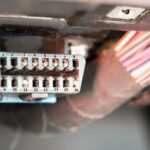Dealing with a check engine light on your Dodge Ram can be frustrating, especially when it’s related to the evaporative emission (EVAP) system. If you’re seeing codes or suspect issues with your Dodge Ram OBD2 system and the EVAP monitor, particularly concerning a “cap off” situation, understanding how to address it is crucial. This guide will walk you through the process, focusing on how to use a drive cycle to potentially clear the EVAP monitor and get your Dodge Ram back to optimal performance.
Understanding the Dodge Ram EVAP System and the “Cap Off” Issue
The EVAP system in your Dodge Ram is designed to prevent harmful fuel vapors from escaping into the atmosphere. A critical component of this system is the fuel cap. When the system detects a potential leak, often triggered by a loose or missing fuel cap – the “cap off” condition – it will illuminate the check engine light and may set diagnostic trouble codes (DTCs) related to EVAP leaks, such as P0455, P0456, or most commonly, P0457 (Evaporative Emission System Leak Detected – Fuel Cap Loose/Off).
Why the EVAP Monitor Matters for Your Dodge Ram
The EVAP monitor is a part of your Dodge Ram’s OBD2 system that regularly checks the integrity of the evaporative emissions system. It ensures that no fuel vapors are leaking, contributing to air pollution and potentially affecting your vehicle’s fuel efficiency. If the EVAP monitor detects a problem, it will not reach a “ready” status, which can cause issues when you need to pass an emissions test.
Diagnosing the “Cap Off” Issue: OBD2 and Code P0457
When your OBD2 scanner flags an EVAP system issue, especially in relation to a “cap off” condition, the first and simplest step is to check your fuel cap. Ensure it is properly tightened and not damaged. Sometimes, simply tightening a loose gas cap can resolve the issue. However, the check engine light and the monitor might not clear immediately. This is where a drive cycle comes into play.
Performing a Dodge Ram EVAP System Drive Cycle
A drive cycle is a specific series of driving conditions that helps your Dodge Ram’s onboard computer to run self-tests on various systems, including the EVAP system. By completing a drive cycle, you’re giving your vehicle the opportunity to re-evaluate the EVAP system after you’ve addressed the potential “cap off” issue.
Here’s an EVAP system drive cycle procedure adapted from Chrysler guidelines, suitable for your Dodge Ram:
Pre-Conditions for the EVAP Drive Cycle
Before starting the drive cycle, ensure these conditions are met:
- No Active DTCs: Use an OBD2 scanner to confirm there are no active EVAP system DTCs present. Clear any codes and address any mechanical issues first.
- Fuel Level: Your fuel tank should be between 1/2 and full. While some monitors might run with fuel levels between 15% and 85%, it’s best to be within the 1/2 to full range for this specific drive cycle.
- No Evaporative DTCs Present: Double-check that there are no pending or current evaporative system diagnostic trouble codes.
- MIL is Off: The Malfunction Indicator Lamp (check engine light) should be off.
Step-by-Step Drive Cycle Procedure
Follow these steps to perform the EVAP system drive cycle on your Dodge Ram:
- Idle: Start your Dodge Ram and let it idle for five minutes. This allows the engine to reach closed loop operation, a necessary condition for many OBD2 monitors to run.
- Steady Speed Driving: Drive at a steady speed between 30 and 45 mph for 2 minutes. Maintain a consistent throttle input during this period.
This image is relevant as it depicts engine maintenance, a general context for OBD2 system checks and drive cycles.
This procedure encourages the EVAP monitor to run its tests. After completing these steps, you can use your OBD2 scanner to check if the EVAP monitor status has changed to “ready” or “complete”.
Beyond the Drive Cycle: Further Troubleshooting
If the EVAP monitor still doesn’t set to “ready” after performing the drive cycle, or if the check engine light returns, there might be other issues within the EVAP system beyond just a loose gas cap. Potential problems could include:
- Faulty Fuel Cap: Even if tightened, the fuel cap itself might be damaged or not sealing properly.
- Vacuum Leaks: Cracks or leaks in vacuum lines within the EVAP system.
- Purge Valve or Vent Valve Issues: Malfunctioning valves that control vapor flow in the system.
- Charcoal Canister Problems: Damage or saturation of the charcoal canister, which stores fuel vapors.
In such cases, further diagnosis by a qualified mechanic is recommended. They can perform smoke tests and other diagnostic procedures to pinpoint the exact cause of the EVAP system leak and ensure your Dodge Ram is running cleanly and efficiently.
By understanding the importance of the EVAP monitor and how to perform a drive cycle, you can take proactive steps to address “cap off” related issues on your Dodge Ram and maintain your vehicle’s emissions system in good working order.
